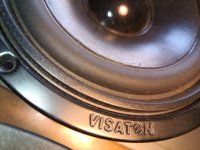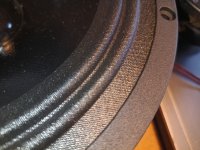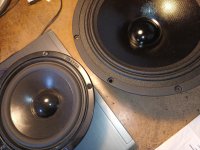Hi Turbowatch. Which Visaton simulation were you referring to? If it's the WS170 mid-bass I don't think we've looked at a crossover. The Alto 1 kit doesn't publish a crossover, it's in the kit.
In the Visaton Shop I found another design, the Bijou 170. This actually does have a crossover for the WS170 and SC 10 N fabric tweeter at 3.2K. This could be a viable starting point since in a 20 litre sealed box we get F3 at 50hz, which is the best so far. Maybe the tweeter could be replaced?
http://www.visatonshop.at/en/Kits/2-Way-Speakers/Bausatz-Bijou-170-Light-Stueck.html
Attached simulations for 20 litre sealed and 30 litres sealed if I add another aluminium piece to the sides. The bass response in 30 litres looks really good - F3 is 47Hz. 30 litres also opens up the box for numerous 8" designs with waveguide.
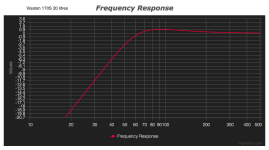
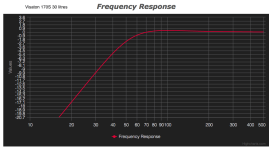
In the Visaton Shop I found another design, the Bijou 170. This actually does have a crossover for the WS170 and SC 10 N fabric tweeter at 3.2K. This could be a viable starting point since in a 20 litre sealed box we get F3 at 50hz, which is the best so far. Maybe the tweeter could be replaced?
http://www.visatonshop.at/en/Kits/2-Way-Speakers/Bausatz-Bijou-170-Light-Stueck.html
Attached simulations for 20 litre sealed and 30 litres sealed if I add another aluminium piece to the sides. The bass response in 30 litres looks really good - F3 is 47Hz. 30 litres also opens up the box for numerous 8" designs with waveguide.


Better match for 8 ohm transformer...smoooth , fixed 40 ohm peak, sealed 24 liters , same baffle.
Many thanks for that. The response on your sims falls 5db or so below 1K. Should I be worried about that? The baffle will be wider than the original, though. I don't know what that will achieve. Troel's published frequency response in 16ltr ported is flatter. I'd like to know what's happening here if I'm thinking of using Troels' design.
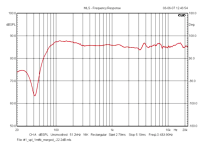
Hi Andy, I looked at the two last simulations. The Visaton with a waveguided 25mm tweeter runs it at it's resonance frequency of 1600Hz. The single capacitor (6dB) with such a low x-over frequncy will not work.
The next simulation has no baffle step correction. It will sound weak in the complete lower range (sub 500Hz). Such speaker only come alive when you crank them up, because our listening has this build in "loudness feeling". No speaker for Andy!
Over the years I have build quite some speakers from well known chassis. I know the faults that you will hear, even if a simulation seems not so far off. If you want a nice two way with good chassis for reasonable money, in practice you usually end up with a 12dB/oct x-over around 2000 Hz. Many of these need a lot of amp power, even for moderate levels. Please keep your eyes on the dB a speaker does for an input of 1 Watt. If you compare a 84 dB 1W/meter with a 90 dB combination, the second virtually makes your 4 Watt amp behave like 16 Watt.
I attach a picture of the Visaton W170S you just mentioned, compare it to another chassis. Membrane suspension and magnet size. Your amp has a lot less work to do on the large speaker and and can play much louder! 86dB compared to 93dB!
This point has been ignored in some parts of this thread. Even when your amp plays loud enough on paper, music is dynamic. While the average may be only a fraction of a watt, some short impulses will need quite some energy. You will not even consider these to be very loud, it just takes more energy to produce them.
So the conclusion: I don't listen loud, so I don't need amp power and can use a low effiency loudspeaker is wrong.
You are a musician, so you will like good recordings, not over compressed main stream chart junk. Jazz music is often very impulsive, an amp running into it's limit sounds just awfull, even at a low level. A 3dB more sensitive speaker will double your headroom.
So, the usual low effiency, compact 6 1/2" plus 1" Hifi speaker will not be right for you.
For example, the MAGICO 1A you mentioned, would be a huge disapontment in your room, with your amp and listening profile. Even a 50W valve amp is no match for it. A typical example of a small speaker that needs a very powerfull A/B or D amp even for low level listening, just to controll the chassis and crossover parts. Think of 250 Watt or an amp build for extreme low output impedance, which usually comes with high Watt numbers. Even if you use only 1,5 W from it, a powerfull amp can make sense.
PS Visaton stuff is extremely overpriced. 59€ for the W170s is ridiculous!
The next simulation has no baffle step correction. It will sound weak in the complete lower range (sub 500Hz). Such speaker only come alive when you crank them up, because our listening has this build in "loudness feeling". No speaker for Andy!
Over the years I have build quite some speakers from well known chassis. I know the faults that you will hear, even if a simulation seems not so far off. If you want a nice two way with good chassis for reasonable money, in practice you usually end up with a 12dB/oct x-over around 2000 Hz. Many of these need a lot of amp power, even for moderate levels. Please keep your eyes on the dB a speaker does for an input of 1 Watt. If you compare a 84 dB 1W/meter with a 90 dB combination, the second virtually makes your 4 Watt amp behave like 16 Watt.
I attach a picture of the Visaton W170S you just mentioned, compare it to another chassis. Membrane suspension and magnet size. Your amp has a lot less work to do on the large speaker and and can play much louder! 86dB compared to 93dB!
This point has been ignored in some parts of this thread. Even when your amp plays loud enough on paper, music is dynamic. While the average may be only a fraction of a watt, some short impulses will need quite some energy. You will not even consider these to be very loud, it just takes more energy to produce them.
So the conclusion: I don't listen loud, so I don't need amp power and can use a low effiency loudspeaker is wrong.
You are a musician, so you will like good recordings, not over compressed main stream chart junk. Jazz music is often very impulsive, an amp running into it's limit sounds just awfull, even at a low level. A 3dB more sensitive speaker will double your headroom.
So, the usual low effiency, compact 6 1/2" plus 1" Hifi speaker will not be right for you.
For example, the MAGICO 1A you mentioned, would be a huge disapontment in your room, with your amp and listening profile. Even a 50W valve amp is no match for it. A typical example of a small speaker that needs a very powerfull A/B or D amp even for low level listening, just to controll the chassis and crossover parts. Think of 250 Watt or an amp build for extreme low output impedance, which usually comes with high Watt numbers. Even if you use only 1,5 W from it, a powerfull amp can make sense.
PS Visaton stuff is extremely overpriced. 59€ for the W170s is ridiculous!
Attachments
Turbowatch - do you actually have a pair of Visaton 170S and can you comment on any experiences using it? It's coated paper like the CA18RLY but that has a spl of 90db as opposed to 86db. I imagine it sounds better - has anyone used it?
I can see all the experts here pushing me towards an 8" driver with a tweeter in a waveguide and a 30 litre cabinet, possibly ported. That's changed my original plans.
I can see all the experts here pushing me towards an 8" driver with a tweeter in a waveguide and a 30 litre cabinet, possibly ported. That's changed my original plans.
The Seas FR in the datasheet is measured in cabinet so you do not have to apply the baffle step loss.The response on your sims falls 5db or so below 1K. Should I be worried about that? The baffle will be wider than the original, though. I don't know what that will achieve. Troel's published frequency response in 16ltr ported is flatter. I'd like to know what's happening here if I'm thinking of using Troels' design.
Simulation vs. TG FR (dashed line) is quite similar.
I think that is an earlier version Bijou 170 Lite. The usual one uses a speaker with an aluminium cone. It was easy to change the cross over of the al one to the W170. This shows the result.Bijou 170
The solid line is with the default 11L sealed box. The dotted line a change to 30L, 20L does the same sort of thing. Looks different to Visaton shots as I use a different scale.
<< I think that is an earlier version Bijou 170 Lite. The usual one uses a speaker with an aluminium cone. It was easy to change the cross over of the al one to the W170. This shows the result.>>
Do you have the crossover for the Bijou 170 alu cone? It's not on the Visaton shop site. Or were you using the Bijou Lite crossover?
Do you have the crossover for the Bijou 170 alu cone? It's not on the Visaton shop site. Or were you using the Bijou Lite crossover?
Why is driving a tweeter at it‘s fs no good? We do this with bass drivers all the time. Now I agree on the need of a distortion check on this one, but the fun with waveguides of course is that you essentially bring level down big time (>10dB) at 1500-2000Hz. Can’t compare that to a bare tweeter.
@Andy in fact I have two pairs of the W170S. It is an unspectacular speaker doing nothing really wrong. I used them closed, but with a sub. Two of them where in a closed box of 21 litres, making the sound for TV set. What they are not, is exciting in any way. If you ask me of personal opinion, I find them boring, that is the cause they went on the shelf. They lack the real bass you expect from the size of the cabinet. With a sub, they sound a lot better.
With not much power aviable, I would avoid a kit with too many parts in the x-over. Each part takes it's share from the limited energy. Usually not a problem, even very small amps have more than 30 clean Watts today. You would be surprised what a cheap TPA3116 delivers, powered by a single 24 Volt brick. We talk about 10 €. Better never try such a thing.
With not much power aviable, I would avoid a kit with too many parts in the x-over. Each part takes it's share from the limited energy. Usually not a problem, even very small amps have more than 30 clean Watts today. You would be surprised what a cheap TPA3116 delivers, powered by a single 24 Volt brick. We talk about 10 €. Better never try such a thing.
<< I have two pairs of the W170S. It is an unspectacular speaker doing nothing really wrong. I used them closed, but with a sub. Two of them where in a closed box of 21 litres, making the sound for TV set. What they are not, is exciting in any way. If you ask me of personal opinion, I find them boring>>
What is the midrange like? Is it detailed with good tone or just boring compared to better units?
Incidentally I have a LM1875 kit I haven't assembled yet.
What is the midrange like? Is it detailed with good tone or just boring compared to better units?
Incidentally I have a LM1875 kit I haven't assembled yet.
@markbakk If you want to use a 25mm dome tweeter as a sub woofer, go on. It is your speaker.
There is a rule not to X over tweeter lower than resonance frequency x2. You will see this is quite clever, as distortion rises at a certain point. You picked a very high resonating tweeter, the Visaton 25FFL is something like 30 or more years old and has never been a high end chassis. It is the entry to HIFI level in the Visaton range. Don't let you fool by the high price, this is a cheap product and you find better tweeter for 20€. Just pick the cheapest SB tweeter.
There is a rule not to X over tweeter lower than resonance frequency x2. You will see this is quite clever, as distortion rises at a certain point. You picked a very high resonating tweeter, the Visaton 25FFL is something like 30 or more years old and has never been a high end chassis. It is the entry to HIFI level in the Visaton range. Don't let you fool by the high price, this is a cheap product and you find better tweeter for 20€. Just pick the cheapest SB tweeter.
I use a LM1875 as a measuring amp if I remember right. Surprisingly good sound.
The W170S is missing the special spark that really good speaker produce when playing good music.
Everything done right, but not exiting. Please, this is a personal opinion. Maybe with some extreme tweeter it can do more.
I plan to use it in an MTM for the porch. Closed with 45 liter net, as they will be screwed to the wall. Maybe with a high pass capacitor to push bass a little. Together with an Audax TW025A0, similar to the HD100. Both are speaker designs from the early 90's , the Audax a step higher in class. For intense listening, I would not take them. For back ground, just fine.
They are worth not more than 20€ in my world, for 56€ there are much more exiting chassis around.
The W170S is missing the special spark that really good speaker produce when playing good music.
Everything done right, but not exiting. Please, this is a personal opinion. Maybe with some extreme tweeter it can do more.
I plan to use it in an MTM for the porch. Closed with 45 liter net, as they will be screwed to the wall. Maybe with a high pass capacitor to push bass a little. Together with an Audax TW025A0, similar to the HD100. Both are speaker designs from the early 90's , the Audax a step higher in class. For intense listening, I would not take them. For back ground, just fine.
They are worth not more than 20€ in my world, for 56€ there are much more exiting chassis around.
Woofer (edit: any cone driver) diaphragms (usually) have two "stacked" suspension systems, the surround and the spider. This limits the possible movement (mostly) to a linear travel in the desired direction.Why is driving a tweeter at it‘s fs no good? We do this with bass drivers all the time.
Dome tweeters and midranges have only one suspension (the surround) and tend to make all sorts of unwanted or even dangerous tumbling wobbling movements once the acoustic impedance is low and the movement is mostly controlled by suspension and not by air inertia, that is near, at or below fs. You can clearly see this in the distorsion graphs.
One possible way to extend useful frequency range - as you mentioned - is to increase acoustic impedance by adding a horn or a waveguide. It is still not good to get near the resonance frequency!
Last edited:
I can show you some 30 year old (Vifa) tweeters that still hang out with the best mid-priced tweeters. Not much has changed in that department. Trust me, a lot of even us won't know the difference tested double blind, just let me adjust level and response...@markbakk If you want to use a 25mm dome tweeter as a sub woofer, go on. It is your speaker.
There is a rule not to X over tweeter lower than resonance frequency x2. You will see this is quite clever, as distortion rises at a certain point. You picked a very high resonating tweeter, the Visaton 25FFL is something like 30 or more years old and has never been a high end chassis. It is the entry to HIFI level in the Visaton range. Don't let you fool by the high price, this is a cheap product and you find better tweeter for 20€. Just pick the cheapest SB tweeter.
And: that rule of thumb for tweeters is generally applicable because of a few reasons. You have to validate those reasons first before you can apply the rule.
But anyway, I picked the relatively cheap soft dome because of the price. The excellent KE25SC fits on the WG148 too, as do a lot of other brands and models. My only point was showing one actually can design something quite easily, without extensive measurements, because Visaton provides quite reliable data. Of course getting the measurement rig up and running is more fun, but for most here that seems the proverbial bridge too far (I'm from Arnhem 🤣 ).
I do a MTM for the Porsche myself ! Joke appart, I have planed a MTM but for the living room with two 5.5" and I sleep like a baby (understand I wake up every hour and I cry !)
Now that is exactly what happens here (like in every 'horn' loaded system). And there is hardly any relation between the resonance frequency of a dome tweeter and it's radiation impedance. Of course domes go rocking at some excursion point. But the G25 in this crossover is 15dB(V) down electrical at 1600Hz. The system does 105dB from 80Hz up before any voice coil leaves the gap too much, at 100W equivalent power. Show me a SET amp that can deliver that.One possible way to extend useful frequency range is to increase acoustic impedance by adding a horn or a waveguide.
It's not dependent on excursion.domes go rocking at some excursion point.
The "problem" is the uneven forces due to magnet gap/surround/coil inaccuracies and of course gravity forces that will let the dome front or voice coil sag very slightly depending on weigth distribution unless you mount it horizontally.
My explanation regarding radiation impedance definitely lacks correct acoustic terminology and is probably not entirely correct. But the double suspension fact is. Some woofers even have triple suspension for better movement control at low frequencies and high excursion.
Last edited:
There is a project file for the alu cone version with cross over details. It's on this siteDo you have the crossover for the Bijou 170 alu cone? It's not on the Visaton shop site. Or were you using the Bijou Lite crossover?
https://boxsim-db.de/
🙁I'm no cross over expert but was curious about what could be done to use the same parts in 20L. This is what came up using boxsim's optimiser with a 20L box. Same crossover circuit, different values.
Tried my best force 8ohms. I decided to model it anechoic. It's possible to set "walls" left , right, above, and below. This reduced the bass level however a separate plot indicates that use in a 1/2 room restores it. Tricky - 😉 need to build a design to see what happens. I doubt if any modelling system can predict what will happen in any room I happen to use a speaker in, The above is also using raw values rather than standard parts. Changing to E12 capacitors seldom causes significant problems - inductors can be a different matter.
I have to admit, I don't know.wrt the fs
It was more an intuitive theory.
Maybe there is another reason for rising h3 distorsion near fs?
The correlation seems to exist, see hificompass' measurements, for example.
Edit: maybe it's the mostly high qts of tweeters leading to potentially high/dangerous/distorting excursion at fs
Last edited:
- Home
- Loudspeakers
- Multi-Way
- Which 6.5" mid-bass for a sealed box?

